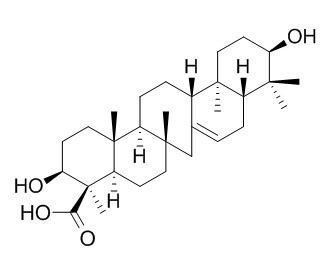Providing storage is as stated on the product vial and the vial is kept tightly sealed, the product can be stored for up to
24 months(2-8C).
Wherever possible, you should prepare and use solutions on the same day. However, if you need to make up stock solutions in advance, we recommend that you store the solution as aliquots in tightly sealed vials at -20C. Generally, these will be useable for up to two weeks. Before use, and prior to opening the vial we recommend that you allow your product to equilibrate to room temperature for at least 1 hour.
Need more advice on solubility, usage and handling? Please email to: service@chemfaces.com
The packaging of the product may have turned upside down during transportation, resulting in the natural compounds adhering to the neck or cap of the vial. take the vial out of its packaging and gently shake to let the compounds fall to the bottom of the vial. for liquid products, centrifuge at 200-500 RPM to gather the liquid at the bottom of the vial. try to avoid loss or contamination during handling.
J Nat Prod. 2002 Jul;65(7):979-85.
Natural products inhibiting Candida albicans secreted aspartic proteases from Lycopodium cernuum.[Pubmed:
12141856]
METHODS AND RESULTS:
Activity-guided fractionation of an ethanol extract of Lycopodium cernuum for Candida albicans secreted aspartic proteases (SAP) inhibition resulted in the identification of six new (1-6) and four known (7-10) serratene triterpenes, along with the known apigenin-4'-O-(2' ',6' '-di-O-p-coumaroyl)-beta-D-glucopyranoside (11). On the basis of spectroscopic analysis, the structures of 1-10 were established as 3beta,14alpha,15alpha,21beta,29-pentahydroxyserratane-24-oic acid (lycernuic acid C, 1), 3beta,14alpha,15alpha,21beta-tetrahydroxyserratane-24-oic acid (lycernuic acid D, 2), 3beta,14beta,21beta-trihydroxyserratane-24-oic acid (lycernuic acid E, 3), 3beta,21beta,29-trihydroxy-16-oxoserrat-14-en-24-methyl ester (lycernuic ketone A, 4), 3alpha,21beta,29-trihydroxy-16-oxoserrat-14-en-24-methyl ester (lycernuic ketone B, 5), 3alpha,21beta,24-trihydroxyserrat-14-en-16-one (lycernuic ketone C, 6), 3beta,21beta-dihydroxyserrat-14-en-24-oic acid (Lycernuic acid A, 7), 3beta,21beta,29-trihydroxyserrat-14-en-24-oic acid (lycernuic acid B, 8), serrat-14-en-3beta,21beta-diol (9), and serrat-14-en-3beta,21alpha-diol (10). The 13C NMR data for the known compounds 7 and 8 are reported for the first time.
CONCLUSIONS:
Compounds 1 and 11 showed inhibitory effects against C. albicans secreted aspartic proteases (SAP) with IC50 of 20 and 8.5 microg/mL, respectively, while the other compounds were inactive.



